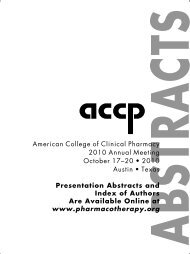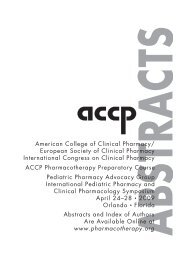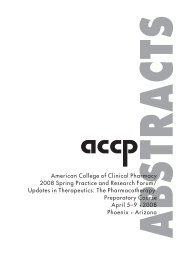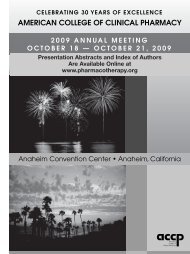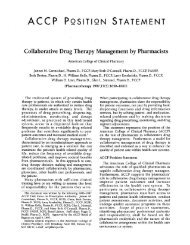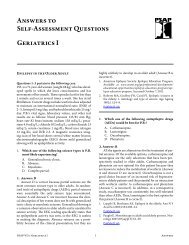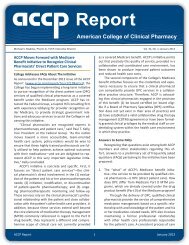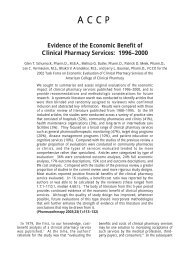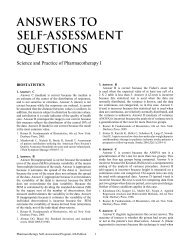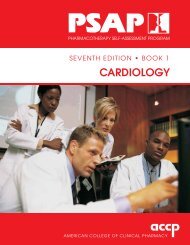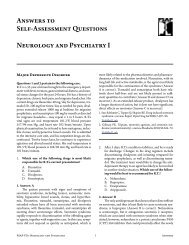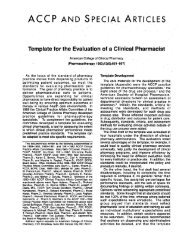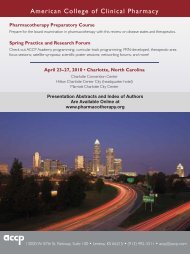Answers to Self-Assessment Questions - ACCP
Answers to Self-Assessment Questions - ACCP
Answers to Self-Assessment Questions - ACCP
Create successful ePaper yourself
Turn your PDF publications into a flip-book with our unique Google optimized e-Paper software.
8. Answer: A<br />
J.G. is receiving propofol at 11 mL/hour, which provides<br />
1.1 kcal/mL through its vehicle (10% fat emulsion). This<br />
amount of propofol will provide 290 kcal/day and 29 g of fat<br />
per day. The amount of fat emulsion in J.G.’s PN formulation<br />
must be reduced <strong>to</strong> avoid overfeeding. Decreasing the lipid<br />
emulsion by 29 g/day (Answer A) will reduce the fat intake by<br />
about the same amount of fat being provided by the propofol<br />
drip; making Answer A the best answer. Decreasing lipid<br />
emulsion by 53 g/day (Answer C) would decrease the lipid<br />
delivery by an amount that exceeds that being provided by<br />
the propofol drip, making Answer C is incorrect. Answer<br />
B (increase lipid emulsion by 29 g/day) and Answer D<br />
(increase lipid emulsion by 53 g/day) are incorrect because<br />
the lipid content should be reduced <strong>to</strong> avoid overfeeding.<br />
Once the propofol drip is discontinued, readjustment of the<br />
PN formulation will be required.<br />
1. Lowrey TS, Dunlap AW, Brown RO, Dickerson RN, Kudsk<br />
KA. Pharmacologic influence on nutrition support therapy:<br />
use of propofol in a patient receiving combined enteral and<br />
parenteral nutrition support. Nutr Clin Pract 1996;11:147–9.<br />
2. Mateu-de An<strong>to</strong>nio J, Barrachina F. Propofol infusion and<br />
nutrition support. Am J Health Syst Pharm 1997;52:2515–6.<br />
9. Answer: C<br />
Thiamine (Answer C) should be supplemented in<br />
J.G.’s PN formulation because it is lost in significant<br />
amounts during CRRT, making Answer C the correct<br />
answer. Thiamine is important in dextrose metabolism,<br />
and supplementation of 50–100 mg/day is recommended<br />
for patients receiving CRRT. Vitamin A (Answer A) and<br />
vitamin D (Answer B) are fat-soluble and are not removed<br />
<strong>to</strong> any appreciable degree during CRRT, so Answer A and<br />
Answer B are incorrect. Although vitamin C (Answer D) is<br />
lost in the CRRT filtrate, the clinical significance of this loss<br />
is unknown, and vitamin C supplementation is not currently<br />
recommended; thus Answer D is incorrect.<br />
1. Berger MM, Shenkin A, Revelly JP, Roberts E, Cayeux MC,<br />
Baines M, et al. Copper, selenium, zinc, and thiamine balances<br />
during continuous venovenous hemodiafiltration in critically<br />
ill patients. Am J Clin Nutr 2004;80:410–6.<br />
2. S<strong>to</strong>ry DA, Ronco C, Bellomo R. Trace element and vitamin<br />
concentrations and losses in critically ill patients treated<br />
with continuous venovenous hemofiltration. Crit Care Med<br />
1999;27:220–3.<br />
10. Answer: D<br />
In patients like J.G. (weight 60 kg) receiving CRRT,<br />
protein intakes of 2.5 g/kg/day have been shown <strong>to</strong><br />
optimize nitrogen balance; thus Answer D (150 g/day) is<br />
correct. Protein intakes less than 2.5 g/kg/day have been<br />
associated with serum amino acid concentrations below the<br />
reference range, whereas protein intakes of 2.5 g/kg/day<br />
are associated with a normalization of serum amino acid<br />
concentrations and a higher prevalence of positive nitrogen<br />
balance. Answer A (60 g/day), Answer B (90 g/day), and<br />
Answer C (120 g/day) provide only 1 g/kg/day, 1.5 g/kg/day,<br />
and 2 g/kg/day of protein, respectively; therefore, Answer<br />
A, Answer B, and Answer C are incorrect because the<br />
protein intake is insufficient <strong>to</strong> meet J.G.’s needs.<br />
1. Scheinkestel CD, Adams F, Mahony L, Bailey M, Davies<br />
AR, Nyulasi I, et al. Impact of increasing parenteral protein<br />
loads on amino acid levels and balance in critically ill anuric<br />
patients on continuous renal replacement therapy. Nutrition<br />
2003;19:733–40.<br />
2. Scheinkestel CD, Kar L, Marshall K, Bailey M, Davies A,<br />
Nyulasi I, et al. Prospective randomized trial <strong>to</strong> assess caloric<br />
and protein needs of critically ill, anuric, ventilated patients<br />
requiring continuous renal replacement therapy. Nutrition<br />
2003;19:909–16.<br />
11. Answer: C<br />
In patients like J.G. with ARF, there are derangements<br />
of serum amino acids. Studies have demonstrated that<br />
patients with ARF should receive an essential–nonessential<br />
amino acid combination when PN is required; thus, Answer<br />
C (essential plus nonessential amino acid combination<br />
formulation) is the correct option for J.G.’s PN formulation.<br />
Essential amino acid–only formulations (Answer A) are<br />
more costly than standard amino acid formulations and have<br />
not been shown <strong>to</strong> produce a clinical benefit; thus Answer<br />
A is incorrect. A nonessential amino acid formulation<br />
(Answer B) would put J.G. at risk of amino acid deficiencies<br />
if essential amino acids were not provided, so Answer B is<br />
incorrect. Modular protein formulations (Answer D) are not<br />
available for administration in PN formulations but are used<br />
in enteral nutrition (EN) <strong>to</strong> supplement oral intake or tube<br />
feeds; therefore, Answer D is incorrect.<br />
1. A.S.P.E.N. Board of Direc<strong>to</strong>rs and the Clinical Guidelines<br />
Task Force. Guidelines for the use of parenteral and enteral<br />
nutrition in adult and pediatric patients. JPEN J Parenter<br />
Enteral Nutr 2002;26S:1SA–6SA.<br />
2. Mirtallo JM, Schneider PJ, Mavko K, Ruberg RL, Fabri PJ.<br />
A comparison of essential and general amino acid infusions<br />
in the nutritional support of patients with compromised renal<br />
function. JPEN J Parenter Enteral Nutr 1982;6:109–13.<br />
3. Feinstein EI, Blumenkrantz MJ, Healy M, Koffler A, Silberman<br />
H, Massry SG, et al. Clinical and metabolic responses <strong>to</strong><br />
parenteral nutrition in acute renal failure: a controlled doubleblind<br />
study. Medicine 1981;60:124–37.<br />
12. Answer: B<br />
J.G. has ARF and is receiving CVVHD with citrate<br />
anticoagulation. Her condition and therapies put her at risk of<br />
both calcium and phosphorus imbalance. Close moni<strong>to</strong>ring<br />
of serum ionized calcium and phosphorus concentrations<br />
is vital; therefore, Answer B (calcium balance should be<br />
frequently assessed by moni<strong>to</strong>ring J.G.’s serum ionized<br />
calcium and serum phosphorus concentrations) is correct.<br />
The serum ionized calcium is more reliable in patients with<br />
hypoalbuminemia, which is common in ARF. Answer A<br />
(citrate anticoagulation will likely induce hypercalcemia,<br />
thus requiring a reduction in the amount of J.G.’s calcium<br />
intake) is incorrect because citrate anticoagulation would<br />
likely induce hypocalcemia because of calcium chelation by<br />
citrate. Because calcium is filtered by CRRT, hypocalcemia<br />
may develop, and the need for calcium supplementation is<br />
common in patients receiving CRRT; therefore, Answer<br />
C (hypocalcemia is rare in patients such as J.G. with ARF<br />
receiving CRRT, and calcium supplementation will not<br />
be required) is incorrect. Hyperphosphatemia is unlikely<br />
because phosphorus is removed by CRRT; however, this<br />
would not preclude correction of hypocalcemia, if necessary.<br />
Therefore, Answer D (calcium supplementation in J.G.<br />
Pharmacotherapy <strong>Self</strong>-<strong>Assessment</strong> Program, 6th Edition 37 Gastroenterology and Nutrition <strong>Answers</strong>



